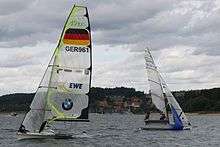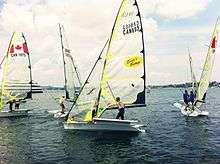49er (dinghy)
|
Class symbol | |
 | |
| Boat | |
|---|---|
| Crew | 2 (double trapeze) |
| Draft | 1,447 mm (4 ft 9 in) |
| Hull | |
| Hull weight | 94 kg (207 lb) |
| LOA | 4,876 mm (16 ft) |
| Beam |
without wings: 1,752 mm (5 ft 9 in) with wings: 2,743 mm (9 ft 0 in) |
| Sails | |
| Spinnaker area | 37.16 m2 (400 sq ft) |
| Upwind Sail Area | 19.97 m2 (215 sq ft) |
| Misc | |
| D-PN | 68.2[1] |
| RYA PN | 740[2] |
| Current Olympic Equipment | |
The 49er and 49er FX is a two-handed skiff-type high-performance sailing dinghy. The two crew work on different roles with the helm making many tactical decisions, as well as steering, and the crew doing most of the sail control. Both of the crew are equipped with their own trapeze and sailing is handled while "flying".
The 49er was designed by Julian Bethwaite, the son of Frank Bethwaite, designer of the Tasar and the popular Laser 2 classes. The boat was selected by the International Sailing Federation after a series of trials for a high performance two person skiff and has been in every olympics since its debut in Sydney Olympics of 2000.
History
The 49er's name comes from its hull length of 4.99 metres. It incorporates ideas developed in Julian Bethwaite's 18ft Skiffs, notably the Prime Computer series of boats, which were double handers.[3]
For a controllable and fast gust response, the mast was carefully tuned to deflect from the top downwards with an increase in wind speed, causing the upper main to twist, reducing the heeling moment. The use of solid wings, rather than tubes as on similar boats (RS800 etc.), aids sailors new to the world of skiff racing while facilitating rapid movement across the 49er during maneuvers.


The 49er made its first Olympic appearance at the Sydney Olympics in 2000 and has continued to grow in popularity ever since.
With a Portsmouth yardstick Handicap of 740 the 49er is the fastest two person one-design monohull dinghy.
In 2009 the boat received a new rig design, including a larger fully carbon mast (replacing the aluminum mast) and square top (roach) mainsail.[4]
Construction
Hull
As a one design class, the 49er has two licensed suppliers, Mackay Boats and Ovington. They are made of Epoxy GRP and foam sandwich laminate with carbon fibre in high load areas. It includes a single hull with two solid wings, also called racks, that clip into the side to generate massive righting moment.[5] The design of the bottom allows the boat to be able to plane easier with less drag to reach high speeds.[6] According to the International 49er class rules, the minimum hull weight including all permanent fittings can not be less than 94.0 kg.[7]

Mast
Licensed supplier of the 49er mast is a company named Southern Spars. It is a three piece male moulded mast made from 100% standard modulus carbon.[8] The height is 7.0 meters tall that is capable of holding a combined crew weight of 155 kg to 165 kg. It contains three sets of shrouds that connect to a fitting on the side of the boat. The crew is able to adjust them by tightening or loosening them, depending on the wind speed and sea states.[9]
Foils
The foils are made out of a hard Gelcoat surface and then different combinations of Epoxy, Carbon and E-glass within the class rules. They are designed to handle the high loads and quick maneuvers the 49er makes while sailing.[10] In order to be legal it shall carry the embossed 49er logo and ICA per certified equipment label at the head of each foil.[7]
Sails
The 49er contains three sails: a main sail, jib, and spinnaker. The main and jib are 20 square meters, fully battened and made of a material called Mylar. The main is also square on top to provide more sail area and to control more shape adjustment. The spinnaker is 38 square meters in a tri-radial asymmetric shape.[5] They provide enough sail power for the boat to plane out of the water and reach high speeds.
Events
Olympics
Men
| Games | Gold | Silver | Bronze |
|---|---|---|---|
| 2000 Sydney |
and Thomas Johanson (FIN) |
and Simon Hiscocks (GBR) |
and Charlie McKee (USA) |
| 2004 Athens |
and Xabier Fernández (ESP) |
and George Leonchuk (UKR) |
and Simon Hiscocks (GBR) |
| 2008 Beijing |
and Martin Kirketerp Ibsen (DEN) |
and Xabier Fernández (ESP) |
and Hannes Peckolt (GER) |
| 2012 London |
and Iain Jensen (AUS) |
and Blair Tuke (NZL) |
and Peter Lang (DEN) |
| 2016 Rio |
and Blair Tuke (NZL) |
and Iain Jensen (AUS) |
and Thomas Plössel (GER) |
Women
| Games | Gold | Silver | Bronze |
|---|---|---|---|
| 2016 Rio de Janeiro |
and Kahena Kunze (BRA) |
and Molly Meech (NZL) |
and Katja Salskov-Iversen (DEN) |
World Championships
Related boats
The 49er FX. Mackay Boats developed the new FX rig for the 49er. Starting with the 49er hull, wings, and foils, the goal was all about designing a rig that would go straight into the existing 49er boats and provide the correct amount of power for the lighter crew target weight specified by ISAF. The boat will be used for the 2016 Olympics in Brazil (women's class). The class has been popular for all women's teams who are lighter in body weight.
The 29er is a smaller, single trapeze trainer to the 49er. It has become popular in North America, Europe and Australia as a fast exciting youth boat. Recently the 29erXX, a twin trapeze version of the 29er, has been produced with a rig very similar to the 49er.
The 59er dinghy was put into production in Australia and the UK in 2002. The 59er is a non-trapeze, 4.7m (15 feet 5 inches) sailing dinghy, rigged with an asymmetric spinnaker. It is designed for a crew weight of 145 kg to 180 kg (320 lb to 400 lb). Performance expectations are that it be similar to the 49er/29er model.
References
- ↑ "Centerboard Classes". US Sailing. Retrieved 31 July 2012.
- ↑ "Portsmouth Number List 2012". Royal Yachting Association. Retrieved 31 July 2012.
- ↑ http://forums.sailinganarchy.com/index.php?showtopic=163903
- ↑ http://www.49er.org/component/option,com_frontpage/Itemid,1/
- 1 2 http://www.ovingtonboats.com/index.php/shop/49er.html
- ↑ http://49er.org/class-info/the-boat/design-elements/
- 1 2 http://www.sailing.org/tools/documents/49er2015CR160115-[18262].pdf
- ↑ http://www.mackayboats.com/mackayboats/assets/File/49erUsers%20Manual%202010%20%20%5BCompatibility%20Mode%5D.pdf
- ↑ http://www.southernspars.com/southernspars/Projects/OneDesign/49erClass/tabid/28060/language/en-US/Default.aspx
- ↑ http://www.mackayboats.com/index.cfm/foils/
External links
| Wikimedia Commons has media related to 49er. |